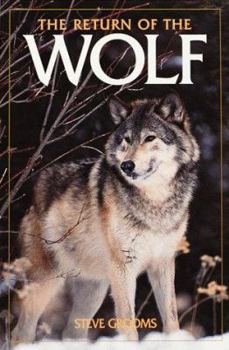The Return of the Wolf
Select Format
Select Condition 
Book Overview
Considered the best single book on both wolf biology and politics, this award-winning best seller is balanced, informed, yet sympathetic. Stunning color photos and lyrical writing combine wisdom about... This description may be from another edition of this product.
Format:Paperback
Language:English
ISBN:1559711515
ISBN13:9781559711517
Release Date:January 1993
Publisher:Northword Press
Length:192 Pages
Weight:1.15 lbs.
Dimensions:0.5" x 6.0" x 9.0"
Customer Reviews
2 ratings
Finally: A fair and balanced account of wolves in America!
Published by Thriftbooks.com User , 20 years ago
The wolf has long both entranced and terrified humans. It wasn't long ago that most of America harbored an intense wolf-hatred, and it was routine to kill as many of them as possible, as quickly as possible. Ranchers saw the wolf as the ultimate danger to their livestock, and offered bounties to wolf-hunters. Such policies quickly led to the depletion or eradication of entire wolf populations in many parts of the continent. Folk tales like "Peter and the Wolf" and "Little Red Riding Hood" are evidence of an even more long-standing fear and hatred of the wolf. Wolves are a predator at the top of the food pyramid, just like humans, so they can seem quite threatening, as our "niches" tend to overlap.More recently, public opinion has seen a dramatic swing in the opposite direction. With the advent of environmentalist groups, the wolf is now seen by many as a symbol of the wild. It is often idolized and viewed as the epitome of nobility. Yet the author of this book asserts that neither this idealized depiction of the wolf, nor the previous view of wolves as bloodthirsty, ruthless killers that should be eradicated at all costs, are accurate perceptions. He states: "People used to view wolves imperfectly through filters of greed and fear; they now view them imperfectly through filters of guilt and romance" (pg. 31). For instance, wolf advocates have often said that wolves will never attack humans, but this is not entirely accurate. While such incidents are rare, "never" is not the correct word to use here.Steve Grooms works to dispell the myths that have evolved around the wolf. He begins by describing its history, the stereotypes attached to the wolf, and the long-standing tradition of persecution. It's not a pretty picture. The book offers several very graphic examples of human brutality toward wolves (some are quite disturbing). Grooms goes on to describe the wolf itself and how it lives. He explains the pack system, a wolf's physical traits, what a wolf eats, where they live, etc. The main portion of the book is devoted to the various issues and controversies surrounding wolves today. Unlike other publications, he does not focus on any one particular breed of wolf, or any one particular issue concerning them. Rather, he goes through and describes each of the breeds on the continent - the Red Wolf, the Gray Wolf of the Great Lakes region, the wolves of the Rocky Mountains, the Mexican Wolf, and finally the large Gray Wolf of Alaska. Grooms explains the controversies surrounding wolves in each area, and the various reintroduction programs (some successful and others not) that have made attempts to reestablish the wolf where its numbers have been severely depleted or entirely wiped out. The most notable of these programs are the restoration of the Red Wolf in the southeast, the Mexican Wolf in the southwest, and Gray Wolves in the Great Lakes Region and in Yellowstone.I found Grooms' presentation to be very fair and balanced. He acknowledges the concer
The first comprehensive book on wolf restoration
Published by Thriftbooks.com User , 24 years ago
Over the last 20 years there has been growing sentiment favoring the restoration of the wolf to many places in the United States where the often feared carnivore was extirpated. Sentiment has been turned onto active restoration, and Steve Grooms is the first to write a book for the general public on the subject. There have been books about the Yellowstone wolf reintroduction and the Mexican wolf reintroduction. However, Grooms looks at them all -- the two just mentioned, but also the restoration of the red wolf and the successful conservation of the gray wolf in the upper Great Lakes.The book has a number of fine photos of wolves. It is factual and moderate in tone.Those is a very useful, readable overview for those interested in the comeback of the wolf





